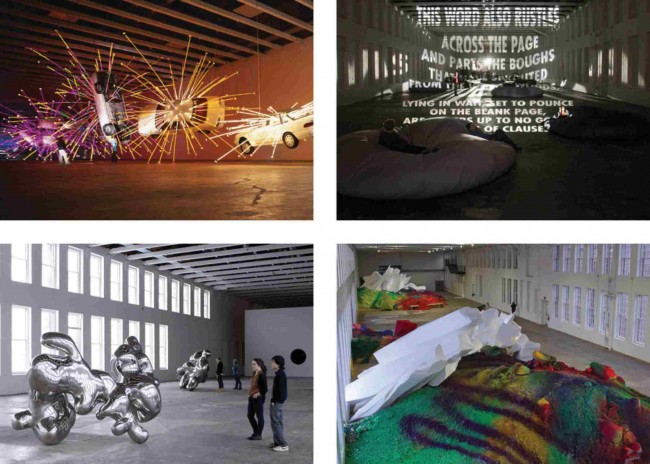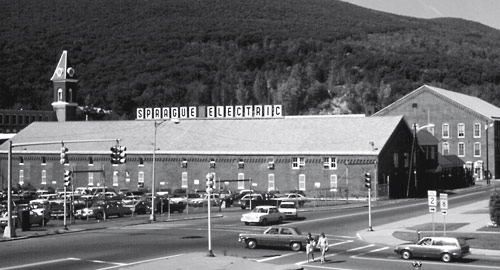In fall of 2009, I sat on my bed in a small apartment surfing the web with the fervor only a student soon-to-be graduate has. I wanted an internship—preferably an affordable one (a tall order in today’s arts economy, to be sure)—at a decidedly Really Cool Place.
Somewhere along the way, I found a link about MASS MoCA’s internship program. It sounded too good to be true, and to be honest.. it very nearly is. The Massachusetts Museum of Contemporary Art is a collection of mind-boggingly huge galleries and venues located in the Berkshire Mountains, an area that looks straight out of a fairy tale (and—fittingly perhaps—is the place Herman Melville wrote his famous tale). No, it’s not in Boston (a running joke among staff); it’s as far as you can get from Boston while still in the state of Massachusetts.
A little history: the galleries and performance venues are in renovated factory buildings constructed by Arnold Print Works (from approximately 1860 to 1890) along the Hoosic River in North Adams, Massachusetts. Arnold Print Works was forced to consolidate as a result of the Great Depression and sold the site to Sprague Electric Company in 1942. Sprague played a major role in the manufacture of materials needed for WWII and later government projects such as the Gemini Moon Missions, but closed in 1985 due to overseas competition. The Director of the nearby Williams College Museum of Art was looking for a large space to exhibit contemporary art and the Mayor of North Adams suggested the huge former Sprague campus (13 acres, to be exact)—voilá. Joseph Thompson, also working at the Williams College Museum of Art, was named founding director of MASS MoCA and after a lot of work to acquire funding, conduct feasibility studies, how to complete renovations, etc., the rest is history. Thompson still spearheads the museum today, working with plenty of other dedicated folks who’ve been there since before the doors opened; they celebrated MoCA’s 15th anniversary in May of this year.
North Adams is small, with neat rows of colorful houses and an overload of cute churches. There’s good food (Jack’s Hot Dogs and The Hub) and plenty of other cultural attractions nearby: Williams College Museum of Art, The Clark Art Institute, Jacob’s Pillow Dance, Natural Bridge State Park and Mount Greylock (the highest point in the state). It’s a cozy, unassuming place for either a weekend getaway or a longer vacation. Tanglewood, the summer of home of The Boston Symphony, is adjacent.
MASS MoCA’s campus feels comfortably human and welcoming. Maybe it’s because when we go to a museum, we’ve come to expect sterile white rooms, gilded gold frames and plenty of signs saying “Don’t Touch The Art.” Maybe it’s because we don’t usually get to look at fine art before a rock concert. It’s a little intoxicating to see art—visual and performance—among exposed brick walls and pipes and old metal staircases and nice big picture windows with breathtaking views. You still shouldn’t touch, but, well… maybe you won’t get yelled at if you do (like being at Grandma’s house: don’t touch, and here’s a cookie instead).
As an intern, I was lucky enough to get a tour of some buildings still awaiting renovation. They’re full of potential and history, and are a little haunting with old Sprague office supplies and hardware hanging around. The MASS MoCA crew is ever resourceful (naturally)—Nari Ward’s 2012 exhibition Sub Mirage Lignum repurposed old Sprague capacitors as part of an installation of giant foam sculptures. That exhibition also included a suspended 30-ft wooden boat and 60-ft replica of a basket-woven fish trap that made me feel like I was standing at the mouth of Jonah’s whale.
Ward’s exhibition wasn’t even in the largest gallery space, which is roughly the size of an American football field. Previous installations in that gallery have included nine cars suspended from the ceiling (Inopportune by Cai Guo Qiang), light projections and large comfy bean bags from which to observe them (Projections by Jenny Holzer), an upside-down house with exterior glass walls (Gravity is a Force to be Reckoned With by Iñigo Manglano-Ovalle), silver particles fabricated at a scale of 25,000 times their original size (The Nanjing Particles by Simon Starling), psychedelic piles of soil and shards of styrofoam during my internship (One Floor Up More Highly by Katarina Grosse), and most recently, two awe-inspiring birds constructed from discarded construction materials in China (Phoenix by Xu Bing: watch an installation video here).

Past exhibitions in Building 5, MASS MoCA’s gallery the size of a football field (clockwise): Inopportune, Projections, One Floor Up More Highly and The Nanjing Particles.
MoCA’s must-see exhibitions are an enormous Sol Lewitt Retrospective and a new long-term exhibition of paintings and sculpture by Anselm Kiefer. Both occupy an entire building: three floors are dedicated to Lewitt’s wall drawings and 10,000 square feet house Kiefer’s rich and layered work.
Lewitt’s wall drawings were executed with great care and precision over six months, and ordered semi-chronologically. The number, scale, and variety of this installation is staggering—this retrospective alone is worth the trip to the Berkshires (TIME named it top exhibition of the year when it first opened). It’s a dizzying maze of color, texture and pattern that one really doesn’t mind getting lost in. Luckily it’s in place until 2033 at least, because it’s an installation that gets better each time you visit. If you’re not a conceptual art connoisseur or familiar with Sol LeWitt, I recommend taking a tour.
In addition to stunning galleries, MASS MoCA attracts crowds for both music and theatre performances. Recent shows have included Beck and Iron & Wine, and huge crowds (we’re talking 4,000+) appear for the annual Solid Sound festival that’s curated by Wilco. MoCA also hosts the Bang On A Can Summer Music Festival, which provides composers and performers a chance to explore contemporary music and share it daily in the galleries (sadly, this just ended the first week of August.. but take note for next year). There’s films showing both indoors and outdoors in the courtyard, and a beer garden during warm summer months. Oh, and of course there’s Kidspace, a set of galleries and exhibitions and activities especially for the small ones.
Currently on view (in addition to the year-round Sol Lewitt Retrospective and seasonal exhibitions including Anselm Kiefer) is a survey of works by Izhar Patkin called the Wandering Veil (a beautiful installation in MoCA’s largest gallery; review by the Boston Globe here), Uncertain Beauty by Darren Waterston (a contemporary interpretation of James McNeill Whistler’s Peacock Room; another review by the Globe here), Eclipse by Elizabeth Kolbert and Sayler/Morris (exploring extinction through the story of the once-plentiful passenger pigeon), The Dying of the Light: Film as Medium and Metaphor featuring the work of six artists, and… plenty more.

Current exhibitions on view at MASS MoCA (clockwise): Eclipse, The Dying of the Light: Film as Medium and Metaphor, The Wandering Veil and Uncertain Beauty.
What made me fall in love with MASS MoCA? Several things: the love and dedication of the staff, from the interns to security to senior management. Their ability to ask “What’s art? We’re not sure, but let’s find out.” The inclusive nature, where experimentation and questions are not only encouraged but actively sought. The fusion of visual art, installation, performance, music, and festivals defines this most contemporary of art spaces. I’m looking forward to seeing what MASS MoCA does for the next 15 years.
By Danelle Cheney with gracious help from Marissa Kurtzhals
More information can be found at massmoca.org and explorenorthadams.com.







